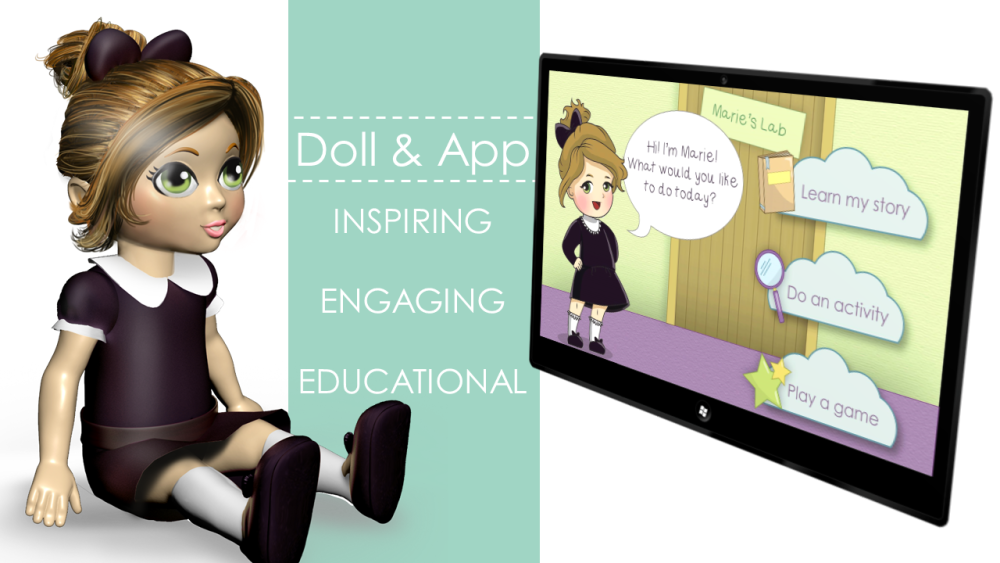By Jodi S. Cohen
Chicago Tribune.
If a University of Illinois engineering student and a recent graduate are successful, girls soon will be accessorizing their dolls with science safety goggles and lab coats instead of hair bows and purses.
Supriya Hobbs, who graduated in May with a chemical engineering degree, and Janna Eaves, a U. of I. senior majoring in materials science and engineering, are behind the toy start-up Miss Possible, which aims to get girls interested in science and engineering through dolls and related apps that guide them through hands-on experiments and on-screen games.
They have raised more than $80,000 since mid-July to start production of the first doll, based on two-time Nobel Prize winner Marie Curie.
The doll will resemble a 14-inch-tall, child-like version of the chemist and physicist, complete with a purple dress and lab coat.
The Curie doll also will come with a downloadable app that walks children through various science activities, including how to make slime and a compass with household ingredients.
They plan to initially manufacture 5,000 dolls, and begin selling them in January online and in stores for about $45. Their target is 5- to 10-year-old girls.
“We want to help more girls see engineering as an option. We thought toys would be a great way to reach girls at an early age,” said Hobbs, 22, now an engineer at Eli Lilly and Co. in Indianapolis.
The Miss Possible dolls will hit the market during a time when there’s pressure on companies to move away from gender-stereotyped toys and also to find ways to incorporate technology with hands-on play.
Lego, for example, this summer released a set of women scientist mini figures — a paleontologist, astronomer and chemist — that come with scientific instruments such as a microscope. The figures quickly sold out.
“The industry is refreshing itself. More people are paying attention to messages about gender and what you can and can’t do. I definitely see us among that wave,” Hobbs said.
At U. of I, Hobbs and Eaves volunteered in local schools and with Girl Scout troops, and soon realized that some girls had distanced themselves from science.
They watched middle school girls give up as they tried to build rubber-band solar cars, making comments such as “We can’t do this — we are girls,” Eaves, 21, recounted.
And, as the two looked around their U. of I. engineering classes, they were keenly aware that they were a minority.
Just 11 percent of working engineers are women, according to the National Science Foundation, a problem that Hobbs and Eaves decided they wanted to help solve.
The two students decided to put their classroom training into practice, doing what engineers do: Solve a problem.
They met one night in their dorm — where they lived on a floor for aspiring entrepreneurs — to work on a solution, and came up with the doll idea.
“We wanted to help more girls see engineering as an option,” Hobbs said. “What had inspired us to be engineers was this idea of wanting to save the world. There are a lot of ways to do that. That sort of became our focus: How do we get girls to dream bigger?”
They entered several entrepreneurship competitions and officially launched the company in January. They started raising money through an Indiegogo campaign — at http://www.indiegogo.com/projects/miss-possible-dolls-to-inspire-girls-across-generations — in mid-July.
The fundraising drive ends Aug. 16, and the company then will begin accepting pre-orders at bemisspossible.com.
After Curie, the company plans to manufacture dolls modeled after computer programmer Ada Lovelace and aviator Bessie Coleman. “A girl can look at them and make a connection that she can grow up and do amazing things,” Eaves said.
And that’s the message behind the name Miss Possible.
“We want to show all the girls all the possibilities they have. It is not about science and engineering,” said Eaves, who is interning this summer at SpaceX, which designs and manufactures rockets and other spacecraft.
“We want girls to do whatever they want to do and go for it. We want to convey the message that we can do anything.”














































































































































































































































































































































































